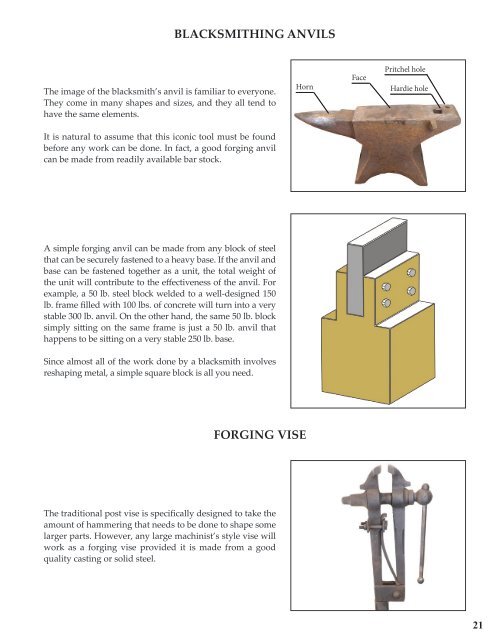The New Spruce Forge Manual of Locksmithing: A Blacksmith’s Guide to Simple Lock Mechanisms
The New Spruce Forge Manual of Locksmithing: a Blacksmith’s Guide to Simple Lock Mechanisms is a totally revised and expanded version of the original work from 1999. This new hardcover edition, at 304 pages and with more than 800 color photos and illustrations, is more than double the size of the original manual. It is divided into two distinct sections: Technical Information - This section is a reference manual in itself that covers the specific tools and techniques needed to build all the parts for each lock, as well as providing the information needed to understand the assembly instructions outlined in the second section. The Locks: Patterns & Instructions - This section provides the plans and detailed instructions for each of the 14 lock projects in this new edition. The clear assembly instructions describe when and how to use the technical information provided in section one. The authors have maintained their original trademark style that relies on well-illustrated step-by-step instructions that guide you through the whole lock-making process. They have also kept their low-tech approach that demonstrates how to go about creating good work using only a handful of simple tools. Making blacksmith locks is an age-old skill the authors of this manual are helping to preserve by passing on their knowledge to this book’s readers. The New Spruce Forge Manual of Locksmithing is also an excellent introduction to benchwork, which is a useful skill for any blacksmith to acquire. This manual will become a valuable, trusted and often referred to sourcebook in your blacksmithing library. Hardcover, 304 pages, more than 800 photos and illustrations.
The New Spruce Forge Manual of Locksmithing: a Blacksmith’s Guide to Simple Lock Mechanisms is a totally revised and expanded version of the original work from 1999. This new hardcover edition, at 304 pages and with more than 800 color photos and illustrations, is more than double the size of the original manual.
It is divided into two distinct sections:
Technical Information - This section is a reference manual in itself that covers the specific tools and techniques needed to build all the parts for each lock, as well as providing the information needed to understand the assembly instructions outlined in the second section.
The Locks: Patterns & Instructions - This section provides the plans and detailed instructions for each of the 14 lock projects in this new edition. The clear assembly instructions describe when and how to use the technical information provided in section one.
The authors have maintained their original trademark style that relies on well-illustrated step-by-step instructions that guide you through the whole lock-making process. They have also kept their low-tech approach that demonstrates how to go about creating good work using only a handful of simple tools.
Making blacksmith locks is an age-old skill the authors of this manual are helping to preserve by passing on their knowledge to this book’s readers. The New Spruce Forge Manual of Locksmithing is also an excellent introduction to benchwork, which is a useful skill for any blacksmith to acquire. This manual will become a valuable, trusted and often referred to sourcebook in your blacksmithing library.
Hardcover, 304 pages, more than 800 photos and illustrations.
You also want an ePaper? Increase the reach of your titles
YUMPU automatically turns print PDFs into web optimized ePapers that Google loves.
BLACKSMITHING ANVILS<br />
<strong>The</strong> image <strong>of</strong> the blacksmith’s anvil is familiar <strong>to</strong> everyone.<br />
<strong>The</strong>y come in many shapes and sizes, and they all tend <strong>to</strong><br />
have the same elements.<br />
Horn<br />
Face<br />
Pritchel hole<br />
Hardie hole<br />
It is natural <strong>to</strong> assume that this iconic <strong>to</strong>ol must be found<br />
before any work can be done. In fact, a good forging anvil<br />
can be made from readily available bar s<strong>to</strong>ck.<br />
A simple forging anvil can be made from any block <strong>of</strong> steel<br />
that can be securely fastened <strong>to</strong> a heavy base. If the anvil and<br />
base can be fastened <strong>to</strong>gether as a unit, the <strong>to</strong>tal weight <strong>of</strong><br />
the unit will contribute <strong>to</strong> the effectiveness <strong>of</strong> the anvil. For<br />
example, a 50 lb. steel block welded <strong>to</strong> a well-designed 150<br />
lb. frame filled with 100 lbs. <strong>of</strong> concrete will turn in<strong>to</strong> a very<br />
stable 300 lb. anvil. On the other hand, the same 50 lb. block<br />
simply sitting on the same frame is just a 50 lb. anvil that<br />
happens <strong>to</strong> be sitting on a very stable 250 lb. base.<br />
Since almost all <strong>of</strong> the work done by a blacksmith involves<br />
reshaping metal, a simple square block is all you need.<br />
FORGING VISE<br />
<strong>The</strong> traditional post vise is specifically designed <strong>to</strong> take the<br />
amount <strong>of</strong> hammering that needs <strong>to</strong> be done <strong>to</strong> shape some<br />
larger parts. However, any large machinist’s style vise will<br />
work as a forging vise provided it is made from a good<br />
quality casting or solid steel.<br />
21










